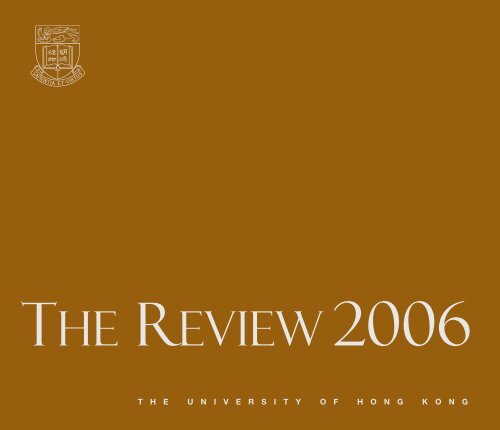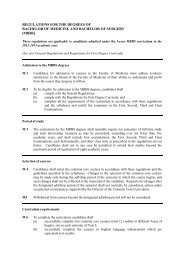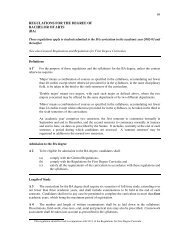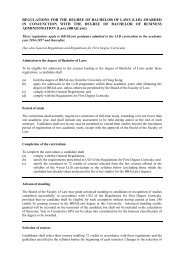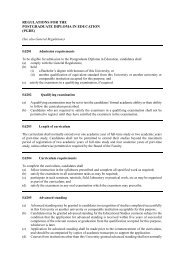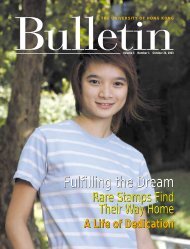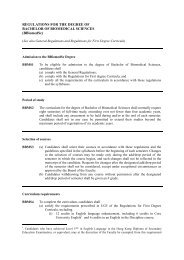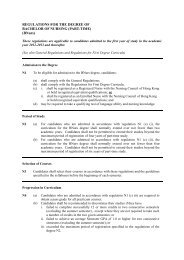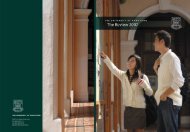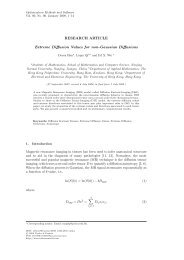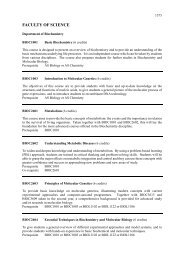2006 Review - The University of Hong Kong
2006 Review - The University of Hong Kong
2006 Review - The University of Hong Kong
Create successful ePaper yourself
Turn your PDF publications into a flip-book with our unique Google optimized e-Paper software.
<strong>The</strong> <strong>Review</strong> <strong>2006</strong><br />
T H E U N I V E R S I T Y o f H o n g K o n g
Contents<br />
<strong>The</strong> <strong>University</strong> <strong>2006</strong><br />
<strong>The</strong> <strong>University</strong> <strong>2006</strong> 1<br />
A Message from the Vice-Chancellor 2<br />
Growing with the Times 6<br />
Preparing for Change 12<br />
Breaking New Ground 20<br />
Endowing the Community 28<br />
<strong>The</strong> <strong>University</strong> Pr<strong>of</strong>ile 34<br />
Further detailed information about this <strong>Review</strong> or<br />
the <strong>University</strong> can be obtained from the Registrar<br />
[fax: (852) 2559 9459]<br />
An extract from the <strong>University</strong>’s Annual Accounts 2005-06<br />
Edited by <strong>The</strong> Registrar<br />
Researched and compiled by Kathy Griffin<br />
Designed by trinity & co.<br />
Photography by sinopix photo agency<br />
Printed in <strong>Hong</strong> <strong>Kong</strong> by HeterMedia Services Limited on recycled paper for text.<br />
Performance Indicators<br />
• More top-performing local students were admitted to this <strong>University</strong><br />
than any other local tertiary institution, including 92% <strong>of</strong> applicants<br />
with 5As and 6As in HKAL examinations<br />
• <strong>The</strong> highest number <strong>of</strong> exchange students passed through the<br />
<strong>University</strong> <strong>of</strong> all local tertiary institutions, 525 incoming and 752<br />
outgoing. We also admitted 1,338 students from overseas and<br />
outside the local mainstream school system at all levels <strong>of</strong> study<br />
• <strong>The</strong> highest share <strong>of</strong> funding from the Research Grants Council’s<br />
Competitive Earmarked Research Grants Awards was awarded to<br />
this <strong>University</strong> – $145.7 million for 215 research proposals<br />
• Our academic staff were awarded 24 <strong>of</strong> 59 Croucher Foundation<br />
Senior Research Fellowships, the most <strong>of</strong> any local tertiary institution<br />
Honours<br />
• Honorary degrees were conferred on six outstanding individuals<br />
(see above, right to left): <strong>The</strong> Honourable Dr Vivienne Poy, Lord<br />
Wilson <strong>of</strong> Tillyorn, Pr<strong>of</strong>essor William Ian Rees Davies, Dr the<br />
Honourable Leong Che Hung, Mr Simon K.Y. Lee and Pr<strong>of</strong>essor<br />
Wu Jing Lian<br />
• <strong>University</strong> Fellowships were bestowed on seven distinguished<br />
persons: Pr<strong>of</strong>essor Hou Jiancun, Pr<strong>of</strong>essor Felice Lieh-Mak, Dr<br />
Ambrose So Shu Fai, Dr Tam Wah Ching, Mr Raymond To Kwok Wai,<br />
Ms Serena Yang Hsueh-chi and Dr Yeoh Eng Kiong<br />
• <strong>The</strong> Fellowship <strong>of</strong> the Royal Society in London was bestowed upon<br />
Pr<strong>of</strong>essor Malik Peiris for his research into bird ’flu<br />
• First-class honours in the prestigious State Scientific Technological<br />
Progress Award were given to <strong>Hong</strong> <strong>Kong</strong> scientists for the first time,<br />
to a pioneering team <strong>of</strong> liver transplant surgeons in our Department<br />
<strong>of</strong> Surgery<br />
Published by <strong>The</strong> <strong>University</strong> <strong>of</strong> <strong>Hong</strong> <strong>Kong</strong> ©<strong>2006</strong><br />
<strong>The</strong> <strong>Review</strong> <strong>2006</strong>
S USTAINING<br />
EXCELLENCE<br />
<strong>The</strong> <strong>University</strong> has had an impressive year, receiving record levels <strong>of</strong><br />
funding for research and attracting unprecedented interest in our taught<br />
programmes. We set in train preparations to expand the campus, boost<br />
our staff numbers, invigorate our curriculum and embrace a higher<br />
degree <strong>of</strong> internationalism into our programmes. <strong>The</strong>se achievements and<br />
changes will further advance our international recognition and reaffirm<br />
our commitment to academic excellence.<br />
In 2005-06 our researchers were given a record $145.7 million in<br />
Competitive Earmarked Research Grants, 30 per cent more than any<br />
other local tertiary institution and 31 per cent higher than last year.<br />
<strong>The</strong> research produced at this <strong>University</strong> has local, national and global<br />
significance, as you will read in the Breaking New Ground chapter. Our<br />
teaching programmes also attracted enormous interest in <strong>Hong</strong> <strong>Kong</strong>,<br />
the Mainland and overseas. Almost all local students with outstanding<br />
results applied to us, together with more than 10,000 Mainland students<br />
– double last year’s figure – and more than 7,500 students from overseas<br />
and outside the local mainstream school system, up 31 per cent from<br />
last year.<br />
<strong>The</strong> additional year <strong>of</strong> undergraduate education requires preparation<br />
in three major areas. First, we need more space. Under the Centennial<br />
Campus Development plans, an area west <strong>of</strong> the Main Campus has been<br />
identified that would enable us to increase teaching and research capacity<br />
by 50 per cent. In <strong>2006</strong> we selected a master plan proposal from Wong &<br />
Ouyang (HK) Ltd/Sasaki Associates following wide-ranging consultations<br />
with stakeholders, as described in the Growing with the Times chapter. It<br />
is our intention to continue to approach campus development with a high<br />
degree <strong>of</strong> openness and transparency.<br />
<strong>The</strong> second requirement is staff. In 2005-06 we launched the Centenary<br />
Recruitment Plan, under which 120 additional academic staff are to be<br />
appointed in the next three years aiming for 200 to be in post by 2012.<br />
While universities around the world are in competition for a restricted<br />
number <strong>of</strong> gifted academics, I believe our research excellence, quality<br />
student intake, working relationship with the Mainland and use <strong>of</strong> English<br />
as the medium <strong>of</strong> instruction will make us an attractive base for talented<br />
scholars. Although there will be transitional issues, particularly in respect<br />
<strong>of</strong> space, we are well positioned to resolve these.<br />
As part <strong>of</strong> education reform led by the <strong>Hong</strong> <strong>Kong</strong> SAR Government,<br />
all tertiary institutions will move to a four-year curriculum by 2012. This<br />
change <strong>of</strong>fers a once in a generation opportunity to examine and enhance<br />
our education programmes and to advance our research aspirations.<br />
<strong>The</strong> fundamental strength <strong>of</strong> all world class universities is their staff. As the<br />
global pool <strong>of</strong> gifted academic staff is limited we must retain and attract<br />
the best talent. To provide our teachers and researchers with an exciting<br />
and challenging supportive setting we identified the need to invigorate<br />
<strong>The</strong> <strong>Review</strong> <strong>2006</strong><br />
<strong>The</strong> <strong>Review</strong> <strong>2006</strong>
our human resource management system. To this end, we have redesigned<br />
the system to place emphasis on tractability and performance<br />
reward incentives. <strong>The</strong> first phase involved our academic staff and we are<br />
concurrently in a second phase, concentrating on the support side <strong>of</strong> our<br />
team. Human resource management reforms inevitably result in feelings<br />
<strong>of</strong> uncertainty and anxiety for some and we are trying our best to address<br />
such concerns.<br />
<strong>The</strong> third and most vital area <strong>of</strong> preparation for the switch to four years <strong>of</strong><br />
undergraduate education is curriculum. In recent years the <strong>University</strong> has<br />
sought to extend student learning outside the classroom, provide more<br />
experiential learning and expose students to varied cultural experiences.<br />
<strong>The</strong> redacted curriculum will enable us to enshrine these aims and<br />
prepare students for coping with the ever-changing environment that<br />
marks 21st century life, as described in the Preparing for Change<br />
chapter. <strong>The</strong> principle transitional issue we need to address is the overlap<br />
<strong>of</strong> students on three-year and four-year undergraduate programmes. We<br />
are presently working on the optimum solution to provide both cohorts<br />
with the best opportunities we can <strong>of</strong>fer.<br />
research is one <strong>of</strong> the factors enabling us to attract the brightest students<br />
and scholars and elevate our pr<strong>of</strong>ile among our peers. <strong>The</strong> Times Higher<br />
Education Supplement – QS <strong>2006</strong> ranked us 33rd among the world’s top<br />
universities, and while such rankings do not give a complete picture <strong>of</strong><br />
our achievements, they do indicate that our attainments and standards<br />
are recognised internationally. Our reforms and campus development<br />
plans <strong>of</strong>fer magnificent opportunities for even greater achievements by<br />
our teachers, researchers and students and I have no doubt our star will<br />
advance further towards its zenith.<br />
Finally, for those who are interested in the financial dimension <strong>of</strong> the<br />
<strong>University</strong>’s pr<strong>of</strong>ile, I would like to point out that details <strong>of</strong> our Annual<br />
Accounts 2005-06 have been included at the end <strong>of</strong> this <strong>Review</strong>. I hope<br />
you will find <strong>The</strong> <strong>Review</strong> in its entirety to be an informative and enlightening<br />
snapshot <strong>of</strong> our work over the past year.<br />
In many ways, the changes described above are a return to the original<br />
vision <strong>of</strong> the <strong>University</strong> in 1911. We began as an international institution<br />
admitting students from around the region and further afield. Now, as<br />
we approach our centenary in 2011, we are returning to the vision <strong>of</strong><br />
our founders. <strong>The</strong> high degree <strong>of</strong> internationalism in our teaching and<br />
Pr<strong>of</strong>essor Lap-Chee Tsui<br />
Vice-Chancellor<br />
December <strong>2006</strong><br />
<strong>The</strong> <strong>Review</strong> <strong>2006</strong><br />
<strong>The</strong> <strong>Review</strong> <strong>2006</strong>
GROWING WITH<br />
the TIMES<br />
Important progress was made towards extending the Main Campus and recruiting new staff as we prepared for the 2012<br />
introduction <strong>of</strong> a four-year undergraduate curriculum. We also continued to reform our organisation to make it more<br />
efficient, and appointed our first Archivist.<br />
<strong>The</strong> <strong>University</strong> is approaching two significant milestones, our centenary in<br />
2011 and the adoption <strong>of</strong> a four-year undergraduate curriculum in 2012.<br />
While these represent superb opportunities to celebrate our achievements<br />
and enhance students’ learning experiences, they also require enormous<br />
levels <strong>of</strong> support. Efforts are gathering pace to meet this demand and the<br />
ambitious deadlines we face.<br />
Our most urgent task is to ensure we have the necessary facilities and<br />
staff available for an additional cohort <strong>of</strong> undergraduate students. In<br />
<strong>2006</strong> we put forth proposals on campus expansion to key stakeholders<br />
in the <strong>University</strong> and <strong>Hong</strong> <strong>Kong</strong>. We also continued with efforts to<br />
enhance efficiency and accountability under reforms that began in 2004.<br />
Our commitment to openness will ensure that the changes we are now<br />
undergoing are conducted in a transparent manner, with input from the<br />
whole community.<br />
Centennial Campus and<br />
Recruitment<br />
<strong>The</strong> Government’s decision to increase the normative length <strong>of</strong><br />
undergraduate education in all <strong>Hong</strong> <strong>Kong</strong> tertiary institutions to four<br />
years means our student population will rise by at least one-third from<br />
September 2012. This is both an opportunity and a challenge for the<br />
<strong>University</strong>. We welcome the many possibilities this opens up for the<br />
curriculum, as outlined in the Preparing for Change chapter. However,<br />
we already experience space constraints with the existing student<br />
population. We now need to press ahead urgently with plans for an<br />
expanded campus.<br />
A westward expansion has been earmarked that would increase space<br />
in the main Pokfulam estate by 50 per cent. Our vision is that this new<br />
campus be sustainable, promote both formal and informal learning and<br />
<strong>The</strong> <strong>Review</strong> <strong>2006</strong><br />
<strong>The</strong> <strong>Review</strong> <strong>2006</strong>
e accessible to the local community, thereby creating a ‘<strong>University</strong><br />
District’. Four architectural consortia proposed broad master plans<br />
based on our Vision and we consulted the public on these in the first half<br />
<strong>of</strong> <strong>2006</strong>. A wide range <strong>of</strong> stakeholders was invited to share their views<br />
in keeping with our commitment to involve the community in the entire<br />
process <strong>of</strong> campus development. Staff and students, local residents,<br />
community groups, green groups and the Central and Western District<br />
Council provided input. Four public exhibitions were staged and received<br />
16,000 visitors, who were also asked to give their feedback on the four<br />
plans. Ecological and sustainability issues were <strong>of</strong> particular concern.<br />
After considering all submissions and views, the <strong>University</strong> decided to<br />
award the consultancy contract to Wong & Ouyang (HK) Ltd / Sasaki<br />
Associates. Sustainability and heritage principles figured strongly in<br />
their plan, supporting the aim <strong>of</strong> creating a green oasis in an urban<br />
neighbourhood. Detailed design work is now underway and we will<br />
consult the public on this in 2007. <strong>The</strong> Government has also provided<br />
feedback and agreed to fund up to $1.2 billion <strong>of</strong> the costs. <strong>The</strong> <strong>University</strong><br />
will seek to cover the remaining $1.3 billion needed through donations<br />
and fund-raising activities.<br />
<strong>The</strong> new campus is the hardware in our preparations for the four-year<br />
undergraduate curriculum. We also need to substantially increase the<br />
s<strong>of</strong>tware – the pr<strong>of</strong>essoriate staff. We will need to appoint 200 more<br />
academic staff before 2012 to allow time for them to settle in and participate<br />
in preparations for the new intake. <strong>The</strong> first stage <strong>of</strong> recruitment started in<br />
<strong>2006</strong> and we expect to recruit 120 new staff in the next three years.<br />
Reforming our Organisation<br />
<strong>The</strong> <strong>University</strong> undertook major changes to its governance and<br />
management structure in 2004 to make it more fit for purpose, more<br />
efficient and more accountable. In the spirit <strong>of</strong> this reform, we are continuing<br />
with organisational changes that will enhance our performance.<br />
One <strong>of</strong> our priorities is to appoint full-time Deans in each faculty. All but<br />
two appointments have been made including, during the academic year<br />
2005-06, the Deans <strong>of</strong> Architecture, Arts, Engineering, Science and Social<br />
Sciences. Alongside this we have been rationalising faculty structures<br />
to reduce the administrative load on scholars and promote greater<br />
collaborative, inter- and multi-disciplinary research. In <strong>2006</strong> the Senate<br />
agreed to restructure the Faculty <strong>of</strong> Arts into five schools – Chinese,<br />
Cultures and Humanities, English, Geography, and Modern Languages.<br />
<strong>The</strong> formerly independent Centre <strong>of</strong> Asian Studies was allocated to the<br />
Faculty <strong>of</strong> Social Sciences. And it was agreed to establish a School <strong>of</strong><br />
Biological Sciences in the Faculty <strong>of</strong> Science in July 2007, encompassing<br />
the Departments <strong>of</strong> Botany, Ecology and Biodiversity, and Zoology.<br />
While undergoing all <strong>of</strong> these changes, we have not neglected our roots.<br />
<strong>The</strong> <strong>University</strong> will celebrate its 100th anniversary in 2011, a centenary<br />
that in this corner <strong>of</strong> the world has been shaken by change, war and<br />
revolution. Our entanglement and observations on these and other<br />
events have been largely stored in piecemeal fashion from public view,<br />
and even from the gaze <strong>of</strong> scholars. In <strong>2006</strong> we appointed an archivist,<br />
Stacy Gould (pictured right), to bring our history further into the light and<br />
develop a system for preserving and documenting the <strong>University</strong>’s past,<br />
present and future.<br />
<strong>The</strong> <strong>Review</strong> <strong>2006</strong><br />
<strong>The</strong> <strong>Review</strong> <strong>2006</strong>
10 <strong>The</strong> <strong>Review</strong> <strong>2006</strong><br />
<strong>The</strong> <strong>Review</strong> <strong>2006</strong> 11
PREPARING<br />
for CHANGE<br />
Planning is underway for the coming four-year curriculum for undergraduates, which will strengthen learning experiences<br />
across disciplines and outside the classroom. A central goal is to instil in students the ability to adapt to new situations.<br />
Graduates will operate in a world characterised by rapid change and they must be able to keep pace and comfortably<br />
take on leadership roles.<br />
<strong>The</strong> demands created by globalisation and rapid advances in technology<br />
have added a new dimension to our job as a university. Apart from<br />
cultivating critical thinking and pr<strong>of</strong>essional know-how in our students, we<br />
must work harder than ever to prepare them to cope with unprecedented<br />
and unpredictable change. This imperative comes at a fortuitous time<br />
in <strong>Hong</strong> <strong>Kong</strong>. All tertiary institutions, including this one, will move to<br />
a four-year undergraduate curriculum in 2012, presenting a wonderful<br />
opportunity to expand further the opportunities for learning and equip our<br />
graduates to meet the challenges <strong>of</strong> the 21st century.<br />
A new campus is planned and a new curriculum developed that will<br />
extend students’ learning experiences inside and outside the classroom,<br />
on and <strong>of</strong>f campus, even outside <strong>Hong</strong> <strong>Kong</strong>. It will also stretch them to<br />
cross the boundaries <strong>of</strong> their chosen disciplines further and learn new<br />
strategies and ways <strong>of</strong> thinking. Ultimately, such an education will equip<br />
our graduates to excel at coping with the novel situations and ill-defined<br />
problems that define these times <strong>of</strong> change.<br />
A Strong Student Base<br />
<strong>The</strong> <strong>University</strong> <strong>of</strong> <strong>Hong</strong> <strong>Kong</strong> is fortunate to attract the kind <strong>of</strong> students<br />
who will respond well to the demands that lie ahead. We have striven<br />
to develop quality education that, in <strong>2006</strong>, brought in applicants from<br />
almost every local secondary school, many with an outstanding academic<br />
record. We also received 10,231 applications from high-achievers on the<br />
Mainland, more than double the previous year. At present the <strong>University</strong><br />
is only able to admit 250 <strong>of</strong> these students, which included the top<br />
scoring students in four provinces. We are keen to increase our intake<br />
substantially in future years.<br />
12 <strong>The</strong> <strong>Review</strong> <strong>2006</strong><br />
<strong>The</strong> <strong>Review</strong> <strong>2006</strong> 13
<strong>The</strong> quality <strong>of</strong> our programmes is also attracting growing interest from<br />
overseas students and those outside the local mainstream school<br />
system. Applications from this group rose 31 per cent in 2005-06 to<br />
7,570. We admitted 395 international students from 50 countries to<br />
regular degree programmes. As with Mainland students, our intake is<br />
limited. Nevertheless, the growing appeal <strong>of</strong> our programmes to students<br />
outside <strong>Hong</strong> <strong>Kong</strong> has placed us in healthy competition with the world’s<br />
best universities.<br />
New Horizons in Learning<br />
<strong>The</strong> <strong>University</strong> seeks to <strong>of</strong>fer demanding, student-centred programmes<br />
based on the most modern and effective pedagogy and teaching tools.<br />
<strong>The</strong> move to a four-year undergraduate curriculum in 2012 is an excellent<br />
opportunity to revisit these goals and inject elements that will also<br />
enhance students’ abilities to cope with new and unexpected situations.<br />
Emphasis will be placed on encouraging a flexible approach to studies<br />
so students can cross disciplines, extend learning outside the classroom<br />
and gain a rounded education.<br />
Physically we need to be prepared for enrolment to expand by at least onethird,<br />
and hopefully more if our student intake from outside <strong>Hong</strong> <strong>Kong</strong><br />
is allowed to increase. A campus expansion plan has been proposed,<br />
as described in the Growing with the Times chapter. Its configuration is<br />
intended to promote learning outside the traditional classroom setting<br />
and facilitate student interaction and collaboration.<br />
<strong>The</strong> curriculum must also be reviewed. In <strong>2006</strong> we began the process<br />
<strong>of</strong> proposing ideas and consulting with staff. Choice will be a central<br />
element <strong>of</strong> the new curriculum. Students will still specialise but we want<br />
them to achieve greater balance and variety in their learning. We also<br />
want them to have a wealth <strong>of</strong> experience either by placement abroad<br />
or through performing community or social service in <strong>Hong</strong> <strong>Kong</strong>.<br />
Stephen Luo Jia Yun is a Year 2 LLB student from Shanghai.<br />
“<strong>The</strong> relationship between teachers and students at HKU is quite close<br />
and relaxed. Students are encouraged to solve problems they might<br />
encounter in their future careers, not just pass exams, and there are many<br />
extracurricular activities that we can join. <strong>The</strong> international environment<br />
created by the use <strong>of</strong> English and the large number <strong>of</strong> foreign students<br />
on campus also helps to prepare us for the future.”<br />
14 <strong>The</strong> <strong>Review</strong> <strong>2006</strong><br />
<strong>The</strong> <strong>Review</strong> <strong>2006</strong> 15
<strong>The</strong>se experiences will be considered in the assessment process. <strong>The</strong><br />
Having increased the admission <strong>of</strong> international students, we are keen<br />
Beyond the curriculum, students organise many social, educational and<br />
<strong>The</strong> new curriculum will expose students to more challenges such as<br />
<strong>University</strong> will also continue to use English as the language <strong>of</strong> instruction,<br />
to strengthen opportunities for interaction with local students. A Global<br />
charitable activities through their societies and halls, and individually. <strong>The</strong><br />
how to study and socialise in a new country, how to apply classroom<br />
which is absolutely essential to maintaining an international campus and<br />
Lounge was opened in autumn 2005 to foster this interaction in a<br />
<strong>University</strong>’s General Education Unit also organises more than 40 courses<br />
knowledge in a community setting and even how to get by without<br />
attracting students from abroad.<br />
comfortable, internet-linked venue attractive to young people. In May<br />
each year to broaden student experience. In <strong>2006</strong> Project SEE (Students<br />
electricity (as the engineering students did in Guangxi). Our ultimate<br />
<strong>2006</strong> the Jockey Club Student Village II was <strong>of</strong>ficially opened with three<br />
for Equality and Equity) was launched to bring together our local and<br />
goal is that our graduates will possess not only the skills, experiences<br />
We are mindful <strong>of</strong> the need to engage the community in this process <strong>of</strong><br />
new residential halls which provided accommodation for 900 international<br />
international students and send them overseas to work on such issues<br />
and pr<strong>of</strong>essional knowledge traditionally required for success, but also<br />
change. Stakeholders in the pr<strong>of</strong>essions and business have been asked<br />
students. In the same month we also agreed with the <strong>University</strong> <strong>of</strong> British<br />
as women’s rights and AIDS relief. Several participating students were<br />
wisdom in how to apply them.<br />
to comment on the qualities they seek in graduates. Furthermore, the<br />
Columbia to build a hostel in the province where 100 places would be<br />
inspired to launch their own non-governmental organisation to benefit<br />
<strong>University</strong> has made significant contributions towards helping others adjust<br />
reserved for our students on exchange. <strong>The</strong> arrangements were made<br />
poor children in Cambodia (see also Endowing the Community chapter).<br />
to the new balance in higher education, including working with secondary<br />
possible by a generous donation from our honorary graduate Dr Simon<br />
schools in the move from a seven-year to six-year curriculum.<br />
K.Y. Lee.<br />
Internationalisation<br />
Educating the Whole Person<br />
An important area <strong>of</strong> change that graduates must be prepared for is<br />
Many effective learning experiences occur outside the confines <strong>of</strong> a<br />
globalisation. It is highly likely that during their working lives, they will<br />
either live abroad or be in regular contact with people from other cultures.<br />
classroom, through internships, student exchanges, community work<br />
and other practical exposure. <strong>The</strong> new four-year curriculum will increase<br />
Kate Jessop is a Year 3 exchange student from Canada.<br />
<strong>The</strong> <strong>University</strong> already <strong>of</strong>fers students numerous opportunities to gain<br />
international exposure and experiences and these will continue to<br />
increase with the four-year curriculum.<br />
Some 54 per cent <strong>of</strong> our academic and research staff originate from<br />
overseas. We also have an active exchange programme, sending 752<br />
<strong>of</strong> our students overseas in 2005-06 and hosting 525 students from 19<br />
the variety <strong>of</strong> these activities and give all our students an opportunity to<br />
learn through direct experience.<br />
A number <strong>of</strong> courses have embedded experiential learning into their<br />
curriculum. Students in the Centre <strong>of</strong> Urban Planning and Environmental<br />
Management, for instance, ventured into Central and Western District<br />
in 2005-06 to interview residents on sustainable planning and hold<br />
“I chose <strong>The</strong> <strong>University</strong> <strong>of</strong> <strong>Hong</strong> <strong>Kong</strong> because <strong>of</strong> its excellent reputation<br />
and the incredible city it is situated in. <strong>The</strong> staff have been very flexible and<br />
helpful, and I love the atmosphere on campus. <strong>The</strong>re is always something<br />
to do, whether it’s having a c<strong>of</strong>fee in the Global Lounge, attending a<br />
seminar or catching up on reading in the impressive and comfortable<br />
campus library.”<br />
countries. Exchanges are organised in several forms, some incorporated<br />
workshops, and their results formed the basis for a report to the local<br />
into a learning programme. For example, in <strong>2006</strong> the Faculty <strong>of</strong> Business<br />
District Council. Social Work students travelled to Tin Shui Wai to<br />
and Economics entered into a unique partnership with the London<br />
investigate the social problems that plague young people’s lives there.<br />
Business School that will require full-time MBA students to complete part<br />
Engineering students helped to design and oversee construction <strong>of</strong><br />
<strong>of</strong> their studies in London. A similar arrangement was also agreed with<br />
a school in a poor rural village in Guangxi, which opened in October<br />
Columbia Business School to commence in 2007.<br />
2005.<br />
16 <strong>The</strong> <strong>Review</strong> <strong>2006</strong><br />
<strong>The</strong> <strong>Review</strong> <strong>2006</strong> 17
18 <strong>The</strong> <strong>Review</strong> <strong>2006</strong><br />
<strong>The</strong> <strong>Review</strong> <strong>2006</strong> 19
BREAKING<br />
NEW GROUND<br />
<strong>The</strong> <strong>University</strong> had a record-breaking year for research funding, receiving 30 per cent more than any other local tertiary institution. Our research work continued<br />
to focus on breadth and collaboration. We produced fascinating results in a wide range <strong>of</strong> fields and entered into working partnerships with other institutions<br />
in <strong>Hong</strong> <strong>Kong</strong>, the Mainland and around the world.<br />
Research and experimentation are the seeds <strong>of</strong> change and progress,<br />
but they cannot reach fruition without the right level <strong>of</strong> support and<br />
fertilisation. We have been very effective in this regard. Our researchers<br />
are provided with a favourable working environment and a framework<br />
for collaborating between disciplines and with our outside partners. As<br />
a result, we have been able to attract outstanding scholars who secure<br />
substantial funding input and produce substantial research findings.<br />
<strong>The</strong> high quality <strong>of</strong> the <strong>University</strong>’s research activities and achievements<br />
was recognised locally, nationally and globally in 2005-06. We received<br />
more research funding than any other tertiary institution in <strong>Hong</strong> <strong>Kong</strong>,<br />
an achievement that has been repeated for most <strong>of</strong> the past decade.<br />
We were also named among the top 40 universities in the Times Higher<br />
Education Supplement – QS <strong>2006</strong> ranking, partly on the basis <strong>of</strong> our<br />
research prowess. While rankings do not provide a complete picture <strong>of</strong><br />
a university’s achievements, they are an indicator that we are recognised<br />
as meeting high international standards.<br />
Research Funding<br />
<strong>Hong</strong> <strong>Kong</strong> has a population <strong>of</strong> only seven million people but eight<br />
universities, all competing for a share <strong>of</strong> research funding that is miniscule<br />
relative to other developed countries. Given the challenge, our <strong>University</strong><br />
has achieved remarkably consistent and superior results. In 2005-06,<br />
our most successful year ever, we continued this strong record and<br />
received $145.7 million in the Competitive Earmarked Research Grants,<br />
31 per cent higher than the previous year and significantly more than<br />
any other tertiary institution. <strong>The</strong> grants covered 215 <strong>of</strong> our applications,<br />
almost one quarter more than last year. We also received $26.4 million<br />
from the Innovation and Technology Support Fund.<br />
20 <strong>The</strong> <strong>Review</strong> <strong>2006</strong><br />
<strong>The</strong> <strong>Review</strong> <strong>2006</strong> 21
Collaboration and Partnership<br />
Collaboration is a central component in research because it encourages<br />
scholars to test each other’s ideas, uncover biases and find novel<br />
solutions. In 2004-05 the <strong>University</strong> sought to provide a framework for<br />
interdisciplinary research with the announcement <strong>of</strong> Strategic Research<br />
Areas, which encompass biotechnology, health, communications,<br />
sustainable environments, information technology, nanoscience, public<br />
law and China studies. A number <strong>of</strong> projects have been initiated in each<br />
area; at the same time, our scholars are broadening research horizons<br />
through co-operative ventures with others in <strong>Hong</strong> <strong>Kong</strong>, the Mainland<br />
and overseas.<br />
<strong>The</strong> international East-West Alliance was announced in April <strong>2006</strong> at the<br />
instigation <strong>of</strong> the <strong>University</strong>’s Li Ka Shing Faculty <strong>of</strong> Medicine. Nine medical<br />
schools in Asia, North America and Europe have agreed to combine<br />
research efforts on cancer and stem cells, infection and immunology,<br />
ageing and imaging, and knowledge transfer and translation. <strong>The</strong> Faculty<br />
is a member <strong>of</strong> the Alliance’s executive together with the <strong>University</strong> <strong>of</strong><br />
Cambridge, the <strong>University</strong> <strong>of</strong> California, Berkeley and the <strong>University</strong> <strong>of</strong><br />
Toronto.<br />
<strong>of</strong> promoting world-class research in collaboration with international<br />
research institutions and distinguished visitor programmes. It is led by a<br />
Distinguished Visiting Pr<strong>of</strong>essor in the Department, Pr<strong>of</strong>essor Daniel C.<br />
Tsui, a Nobel Prize winner in physics.<br />
Breadth <strong>of</strong> Activity<br />
<strong>The</strong> <strong>University</strong>’s 10 faculties produce a great diversity <strong>of</strong> quality research<br />
each year, reflecting our status as a comprehensive university. While<br />
medical research on infectious diseases has attracted much attention<br />
due to international concern about outbreaks, other faculties have also<br />
made significant contributions locally, nationally and globally. A small<br />
selection <strong>of</strong> the past year’s highlights, described below, illustrate the rich<br />
variety <strong>of</strong> our research interests and achievements.<br />
Probing the workings <strong>of</strong> the brain<br />
Three studies in 2005-06 investigated the mystery <strong>of</strong> the brain, with one<br />
suggesting there was hope that functions lost due to brain damage could<br />
be restored.<br />
<strong>The</strong> School <strong>of</strong> Chinese Medicine was part <strong>of</strong> an unprecedented<br />
collaborative effort by six <strong>Hong</strong> <strong>Kong</strong> universities to bring the clinical<br />
application <strong>of</strong> Chinese medicines up to modern standards, under the<br />
umbrella <strong>of</strong> the <strong>Hong</strong> <strong>Kong</strong> branch <strong>of</strong> the international Consortium for<br />
Globalisation <strong>of</strong> Chinese Medicine. <strong>The</strong>y received $10 million from the<br />
Innovation and Technology Fund in September <strong>2006</strong> to join forces on<br />
sleep disorders and post-stroke rehabilitation.<br />
<strong>The</strong> new Centre <strong>of</strong> <strong>The</strong>oretical and Computational Physics in the<br />
Department <strong>of</strong> Physics was established in autumn 2005 with the aim<br />
Abnormalities were discovered in the brains <strong>of</strong> Chinese children with<br />
autism in the connectivity in areas governing social interaction. <strong>The</strong> study<br />
by the Department <strong>of</strong> Psychiatry, working alongside scientists from the<br />
<strong>University</strong> <strong>of</strong> Cambridge, was the first to look at the relationship between<br />
brain structures affected by autism.<br />
Men who physically abuse their families were found to have subtle<br />
differences in their brains when it came to impulse control and cognitive<br />
function, according to preliminary research in the Department <strong>of</strong><br />
Psychology.<br />
22 <strong>The</strong> <strong>Review</strong> <strong>2006</strong><br />
<strong>The</strong> <strong>Review</strong> <strong>2006</strong> 23
And a team <strong>of</strong> scientists from the Department <strong>of</strong> Anatomy and the<br />
Massachusetts Institute <strong>of</strong> Technology successfully reconnected brain<br />
tissue in hamsters using nanotechnology, holding out hope that human<br />
victims <strong>of</strong> brain injuries can regain some functions. <strong>The</strong> treatment restored<br />
partial vision to blind hamsters. <strong>The</strong> initial findings were published in the<br />
American Proceedings <strong>of</strong> the National Academy <strong>of</strong> Sciences.<br />
Promoting the benefits <strong>of</strong> a healthy spirit<br />
<strong>The</strong> Centre <strong>of</strong> Buddhist Studies has initiated research to assess the<br />
effectiveness <strong>of</strong> the application <strong>of</strong> Buddhist concepts in life education for<br />
secondary school students. <strong>The</strong> goal is to devise teaching tools that help<br />
students understand life better, deal with problems and find meaning in<br />
life using Buddhist teachings as a guide.<br />
War and climate change<br />
Climate change may be an underlying mechanism driving the war and<br />
peace cycle, according to research in the Department <strong>of</strong> Geography.<br />
A study <strong>of</strong> climate change and wars in China covering the years 850<br />
– 1911 demonstrated that climate cooling resulted in chaos as harvest<br />
yields fell. This was the first study to tackle scientifically the relationship<br />
between armed conflict and climate change. <strong>The</strong> authors suggested<br />
global warming could also have an impact on conflict and this requires<br />
further study.<br />
Teeth and bones<br />
Researchers in the Faculty <strong>of</strong> Dentistry have substantially improved<br />
the effectiveness <strong>of</strong> a commercially available bone graft material,<br />
resulting in bone growth increases <strong>of</strong> 100-149 per cent. <strong>The</strong>ir findings,<br />
to be published in the International Journal <strong>of</strong> Surgery, could have a<br />
wide range <strong>of</strong> applications, from gum disease to tumour resection and<br />
osteoporosis.<br />
Developing bilingualism<br />
A linguistics study has investigated how young children become bilingual<br />
(pictured left). <strong>The</strong> project, conducted with <strong>The</strong> Chinese <strong>University</strong> <strong>of</strong><br />
<strong>Hong</strong> <strong>Kong</strong>, is the first <strong>of</strong> its kind to pair English and Chinese. It has<br />
resulted in the world’s largest video-linked database on the subject and<br />
a new book on bilingualism in early childhood.<br />
Legal matters<br />
<strong>The</strong> Faculty <strong>of</strong> Law has sought to shed more light on two issues <strong>of</strong> intense<br />
interest in <strong>Hong</strong> <strong>Kong</strong>, the Basic Law and financial markets. <strong>The</strong> Faculty<br />
has worked with the <strong>University</strong> Libraries to make the drafting history<br />
<strong>of</strong> the Basic Law available online, following extensive and continuous<br />
efforts to compile these documents. Researchers in the Faculties <strong>of</strong> Law,<br />
Architecture, and Business and Economics have sought to explain for<br />
the first time the complex legal and regulatory systems supporting <strong>Hong</strong><br />
<strong>Kong</strong>’s financial markets.<br />
Investigating infectious diseases<br />
In addition to these varied achievements, our strength as a world leader<br />
in research on infectious diseases continues to garner funding and<br />
attention. In <strong>2006</strong> the Research Grants Council’s Central Allocation Vote<br />
programme awarded $4.6 million for collaborative research into the H5N1<br />
virus that causes bird ’flu. <strong>The</strong> <strong>University</strong>’s scientists are working with<br />
counterparts from the <strong>Hong</strong> <strong>Kong</strong> <strong>University</strong> <strong>of</strong> Science and Technology<br />
and City <strong>University</strong> <strong>of</strong> <strong>Hong</strong> <strong>Kong</strong>.<br />
Our scholars were also part <strong>of</strong> an international team <strong>of</strong> 28 researchers<br />
from Asia and the United States to conclude that wider surveillance <strong>of</strong><br />
bird influenza than previously thought may be needed to contain an<br />
outbreak. <strong>The</strong> findings were also published in the American Proceedings<br />
<strong>of</strong> the National Academy <strong>of</strong> Sciences.<br />
24 <strong>The</strong> <strong>Review</strong> <strong>2006</strong><br />
<strong>The</strong> <strong>Review</strong> <strong>2006</strong> 25
26 <strong>The</strong> <strong>Review</strong> <strong>2006</strong><br />
<strong>The</strong> <strong>Review</strong> <strong>2006</strong> 27
E NDOWING<br />
the COMMUNITY<br />
<strong>The</strong> <strong>University</strong>, its Faculties and individual staff, students and alumni all make important contributions to <strong>Hong</strong> <strong>Kong</strong><br />
society beyond research and learning. Through voluntary efforts they have sought to address an enormous breadth <strong>of</strong><br />
concerns, such as dental care for the elderly, sustainable development, regional security and appreciation <strong>of</strong> the arts.<br />
As <strong>Hong</strong> <strong>Kong</strong>’s oldest university, we have played a prominent and<br />
important role in the city’s development. Many <strong>of</strong> our graduates hold or<br />
have held positions <strong>of</strong> leadership in society. Our 10 faculties also provide<br />
cutting-edge research to address the challenges facing a wide range<br />
<strong>of</strong> sectors in the community. But apart from teaching and research, the<br />
<strong>University</strong> has other valuable contributions to make to the community.<br />
Our staff, students and alumni have undertaken an enormous range <strong>of</strong><br />
voluntary activities, in the spirit <strong>of</strong> helping others. <strong>The</strong> cultivation <strong>of</strong> this<br />
spirit is an important part <strong>of</strong> the <strong>University</strong>’s success because it helps to<br />
contribute to the betterment <strong>of</strong> <strong>Hong</strong> <strong>Kong</strong> – our ultimate goal.<br />
<strong>University</strong> Initiatives<br />
<strong>The</strong> <strong>University</strong> recognises it has a social responsibility to contain its<br />
environmental impacts and set a positive example to others. We are<br />
the only tertiary institution in <strong>Hong</strong> <strong>Kong</strong>, and one <strong>of</strong> the few in the<br />
world, to publish an annual Sustainability Report, which describes our<br />
environmental, social and financial impacts and where we are implementing<br />
improvements. Sustainability has in fact become a guiding principle in our<br />
decision-making, as seen in the plans for our new Centennial Campus<br />
(details are in the Growing with the Times chapter).<br />
In 2005-06 there were numerous examples where the <strong>University</strong>, its faculties<br />
and individual members stepped beyond their prescribed responsibilities<br />
to carry out activities that helped to improve our community.<br />
In 2005-06 we also took the initiative to ban shark’s fin soup at <strong>of</strong>ficial<br />
functions to protect this species, and purchased a hybrid car for our<br />
vehicle fleet. Our efforts to incorporate more environmental features into<br />
our newer buildings were recognised at the <strong>2006</strong> <strong>Hong</strong> <strong>Kong</strong> Energy<br />
Efficiency Awards, where we won two awards.<br />
28 <strong>The</strong> <strong>Review</strong> <strong>2006</strong><br />
<strong>The</strong> <strong>Review</strong> <strong>2006</strong> 29
Faculty Initiatives<br />
Business and politics<br />
Our faculties are committed to sharing their expertise with the community.<br />
This requires a great deal <strong>of</strong> commitment and organisation. Several<br />
faculties such as Dentistry, Medicine and Social Sciences provide services<br />
to the public relating to their disciplines, with student involvement.<br />
Academic staff also organise awareness-raising programmes on such<br />
diverse topics as oral health and arts appreciation, and frequently initiate<br />
workshops to bring together local, regional and international academics<br />
and pr<strong>of</strong>essionals to address issues <strong>of</strong> mutual concern. A few <strong>of</strong> the<br />
highlights from 2005-06 are described below.<br />
Social needs<br />
Our faculties try to meet social needs through outreach programmes and<br />
the provision <strong>of</strong> urgently needed services. <strong>The</strong> Faculty <strong>of</strong> Dentistry, for<br />
instance, announced plans in <strong>2006</strong> to build an Implant Centre where<br />
elderly people can get affordable implants (an alumnus also donated<br />
funds for 100 implants, see Individuals below). <strong>The</strong> Faculty <strong>of</strong> Social<br />
Sciences organised student volunteers to take disadvantaged young<br />
people from Tin Shui Wai on a rare trip to <strong>Hong</strong> <strong>Kong</strong> Island. <strong>The</strong> Faculty<br />
<strong>of</strong> Education organised an international conference on special education,<br />
bringing together scholars and pr<strong>of</strong>essionals from around the world.<br />
Security and governance were the themes <strong>of</strong> workshops organised in<br />
autumn 2005 for diplomats and government <strong>of</strong>ficials from around the<br />
region, by the Centre <strong>of</strong> Asian Studies. <strong>The</strong> <strong>University</strong> also hosted a<br />
visit by United Nations’ special envoy Lloyd Axworthy, who spoke on<br />
human security in a globalised world. Globalisation was also the subject<br />
<strong>of</strong> a symposium organised by the Faculty <strong>of</strong> Business and Economics<br />
for corporate chairmen and senior executives, who discussed ‘World<br />
Economic Prospects and the Future <strong>of</strong> Business in China’.<br />
<strong>The</strong> environment<br />
<strong>The</strong> Centre <strong>of</strong> Urban Planning and Environmental Management marked<br />
its 25th anniversary by organising the 12th Annual International<br />
Sustainable Development Research Conference in April <strong>2006</strong> with ERP<br />
Environment – the first time this conference was held in Asia. Our Centre<br />
on Renewable Energy in Architecture helped to organise a solar model<br />
car race for primary and secondary school students in December 2005 to<br />
promote sustainability and the use <strong>of</strong> renewable energy, with <strong>Hong</strong> <strong>Kong</strong><br />
PV Consortium and Kei Wai (Ma Wan) Primary School.<br />
<strong>The</strong> arts<br />
Special recognition was given to <strong>The</strong> <strong>Hong</strong> <strong>Kong</strong> Jockey Club Centre<br />
for Suicide Research and Prevention in September 2005 when it won<br />
the silver award at the 8th Asian Innovation Awards for its website, Little<br />
Prince is Depressed, aimed at de-stigmatising depression.<br />
<strong>The</strong> Faculty <strong>of</strong> Arts promoted arts appreciation and the importance <strong>of</strong><br />
arts in a progressive society through a series <strong>of</strong> radio programmes aired<br />
on Radio Television <strong>Hong</strong> <strong>Kong</strong>. <strong>The</strong> Department <strong>of</strong> Music also signed<br />
a partnership with <strong>Hong</strong> <strong>Kong</strong> Academy <strong>of</strong> Performing Arts’ School <strong>of</strong><br />
Music to formalise their artistic and pedagogical collaborations, and was<br />
rewarded with a Balinese painting and a special performance <strong>of</strong> Balinese<br />
dance for efforts to promote Indonesian gamelan music.<br />
30 <strong>The</strong> <strong>Review</strong> <strong>2006</strong><br />
<strong>The</strong> <strong>Review</strong> <strong>2006</strong> 31
Individuals<br />
Many members <strong>of</strong> the <strong>University</strong> community make significant contributions<br />
<strong>of</strong> their own time and money towards the betterment <strong>of</strong> society. For<br />
example, in summer <strong>2006</strong> a group <strong>of</strong> law and social science students<br />
launched a non-governmental organisation to help educate poor children<br />
in Cambodia, after spending one month in the country under the General<br />
Education Unit’s Project SEE (see Preparing for Change chapter).<br />
<strong>The</strong>y follow in the footsteps <strong>of</strong> other student-led initiatives such as the<br />
China Education Association, which supports Mainland education and<br />
organised a barefoot marathon in November 2005 to highlight the plight<br />
<strong>of</strong> poor rural children in China.<br />
Care for the environment is also an area <strong>of</strong> student concern. Two students,<br />
one a PhD candidate, the other an undergraduate, created enrichment<br />
toys for pandas (pictured left) while on a <strong>2006</strong> project sponsored by<br />
the Ocean Park Conservation Foundation, <strong>Hong</strong> <strong>Kong</strong>, to enhance<br />
awareness <strong>of</strong> the conservation <strong>of</strong> endangered Asian animals. An MPhil<br />
student, Jacky Chan, helped to launch the Eco-Education and Resource<br />
Centre to document wild animal sightings in <strong>Hong</strong> <strong>Kong</strong> and organise<br />
educational tours for the public.<br />
student projects that promote opportunities for people with disabilities.<br />
Engineering alumnus Dr Nicolas Yeung financed the construction <strong>of</strong> a<br />
new school in rural Guangxi, which opened in October 2005 and involved<br />
our engineering students (see details in Preparing for Change chapter).<br />
<strong>The</strong> <strong>University</strong> is also the recipient <strong>of</strong> alumni generosity. As we prepare<br />
to expand our campus and student numbers amid the variability<br />
<strong>of</strong> government funding, their continued support will be increasingly<br />
important. In <strong>2006</strong> Class <strong>of</strong> ’72 alumni Mr Lawrence Fung Siu Por and<br />
his wife Mrs Alexandra Fung Lee Suk Wai kindly donated 10 per cent <strong>of</strong><br />
the issued share capital <strong>of</strong> the <strong>Hong</strong> <strong>Kong</strong> Economic Times Holdings<br />
Limited, equivalent to about $91 million. <strong>The</strong> fund has been named the<br />
Azalea (1972) Endowment Fund and its first project is the dental implant<br />
service for the elderly described above in Faculty-level initiatives.<br />
Moreover, Dr Stanley Ho, one <strong>of</strong> our honorary graduates, set up a<br />
matching fund in November 2005 in which he will equal donations dollarfor-dollar<br />
up to $500 million over five years. Contributions like these help to<br />
ensure that the <strong>University</strong> can continue to provide teaching programmes,<br />
research and community services that invigorate and advance <strong>Hong</strong><br />
<strong>Kong</strong> society.<br />
<strong>The</strong> desire to improve society also carries through to our alumni, who<br />
make many generous donations to a variety <strong>of</strong> causes. <strong>The</strong> Class <strong>of</strong> ’81<br />
launched an Inclusion Fund in <strong>2006</strong> – their 25th anniversary – to finance<br />
32 <strong>The</strong> <strong>Review</strong> <strong>2006</strong><br />
<strong>The</strong> <strong>Review</strong> <strong>2006</strong> 33
<strong>The</strong> <strong>University</strong> Pr<strong>of</strong>ile<br />
Statistical Indicators<br />
Teaching and Learning<br />
1 REGULAR DEGREE PROGRAMMES<br />
UGC and Mixed-funded Programmes<br />
Student Admissions<br />
Research<br />
Postgraduate<br />
Taught<br />
Postgraduate<br />
Undergraduate<br />
0 20 40 60 80 100 %<br />
2 PROFESSIONAL AND CONTINUING EDUCATION PROGRAMMES<br />
Self-financed and Out-reach Programmes<br />
Student Admissions<br />
Taught<br />
Postgraduate<br />
Undergraduate<br />
2004 – 05<br />
2005 – 06<br />
2004 – 05<br />
2005 – 06<br />
2004 – 05<br />
2005 – 06<br />
Admissions – Local Students<br />
Admissions – Non-local Students<br />
2004 – 05<br />
2005 – 06<br />
2004 – 05<br />
2005 – 06<br />
0 20 40 60 80 100 %<br />
Admissions – Local Students<br />
Admissions – Non-local Students<br />
Number <strong>of</strong> Programmes<br />
Level<br />
Number<br />
2004-05 2005-06<br />
Research Postgraduate 193 198<br />
Taught Postgraduate 63 50<br />
Undergraduate 47 48<br />
All Levels 0 296<br />
(Note: <strong>The</strong> number <strong>of</strong> programmes listed above include where<br />
applicable, programmes <strong>of</strong>fered in the full-time and part-time<br />
modes which are counted as separate programmes. <strong>The</strong><br />
counting <strong>of</strong> research postgraduate programmes is based on the<br />
disciplines/departments in which such programmes are <strong>of</strong>fered.)<br />
Number <strong>of</strong> Programmes<br />
Level<br />
Number<br />
2004-05 2005-06<br />
Taught Postgraduate 111 125<br />
Undergraduate 13 14<br />
All Levels 2 <br />
(Note: Programmes <strong>of</strong>fered both in full- and part-time modes are<br />
counted as separate for each mode.)<br />
Country <strong>of</strong> Origin <strong>of</strong> 2005-06<br />
Incoming Exchange Students<br />
Australasia (38)<br />
APEC (14)<br />
China (143)<br />
European Union and Norway (110)<br />
Japan (13)<br />
Korea (17)<br />
North America (190)<br />
Self-financed Programmes <strong>of</strong>fered by the<br />
HKU School <strong>of</strong> Pr<strong>of</strong>essional and Continuing Education<br />
Programme<br />
Student Admissions by Headcount<br />
2004-05 2005-06<br />
Postgraduate 5,932 5,130<br />
Degree (including full-time programmes) 23,916 32,407<br />
Sub-degree 44,092 35,727<br />
General / Short Courses 28,125 32,684<br />
Community College<br />
(full-time associate degrees and higher diplomas) 4,903 5,760<br />
All Programmes (local) 06,968 111,708<br />
Mainland China Programmes ,083 1,428<br />
3 GRADUATES<br />
From Regular Degree Programmes including UGC and Mixed-funded Programmes<br />
Discipline Research Postgraduate Taught Postgraduate Undergraduate All<br />
Masters<br />
Postgraduate<br />
Diploma/Certificate<br />
2004-05 2005-06 2004-05 2005-06 2004-05 2005-06 2004-05 2005-06 2004-05 2005-06<br />
Architecture 16 23 155 125 - - 120 111 291 259<br />
Arts 60 64 21 3 - - 470 471 551 538<br />
Business and Economics 12 10 - - - - 386 391 398 401<br />
Dentistry 8 5 19 5 2 1 51 49 80 60<br />
Education 15 14 175 310 602 499 130 128 922 951<br />
Engineering 94 86 254 120 2 4 485 449 835 659<br />
Law 5 6 87 22 278 134 101 117 471 279<br />
Medicine 86 101 92 22 - - 255 242 433 365<br />
Science 120 110 83 90 - - 426 463 629 663<br />
Social Sciences 34 34 142 105 10 2 191 203 377 344<br />
All Disciplines 50 453 1,028 802 894 640 2,615 2,624 4,987 4,519<br />
34 <strong>The</strong> <strong>Review</strong> <strong>2006</strong><br />
<strong>The</strong> <strong>Review</strong> <strong>2006</strong> 35
<strong>The</strong> <strong>University</strong> Pr<strong>of</strong>ile<br />
RESEARCH<br />
STAFF<br />
Research Funding Received by Fund Source<br />
Research Output by Type <strong>of</strong><br />
Number <strong>of</strong> Staff by Headcount (as at December 31, 2005)<br />
Research Activities<br />
Regular<br />
Temporary<br />
honorary/<br />
Full-time Full-time Part-time Visiting All Temporary<br />
2004 – 05<br />
Teaching Staff: 1,124 85 66 1,254 1,405<br />
2004 – 05 2005 – 06<br />
Block Grant from <strong>University</strong> Grants Committee<br />
Research Grants Council/<strong>University</strong> Grants Committee –<br />
Competitive Earmarked Research Grants<br />
Research Grants Council/<strong>University</strong> Grants Committee – Others<br />
Research Grants Council Direct Allocation<br />
Other External Sources (Including Government, Private, Industry)<br />
2005 – 06<br />
0 20 40 60 80 100<br />
Academic Research, Refereed<br />
Academic Research, Not Refereed<br />
• Chair Pr<strong>of</strong>essor 70 1 0 365 366<br />
• Teachers (Pr<strong>of</strong>essor, Reader, Associate Pr<strong>of</strong>essor, Senior Lecturer,<br />
Assistant Pr<strong>of</strong>essor, Lecturer and Assistant Lecturer) 834 8 5 761 774<br />
• Teaching Support Staff (Tutor, Instructor, Demonstrator) 220 76 61 128 265<br />
Research Staff 582 438 47 146 631<br />
Technical Staff 835 197 25 7 229<br />
<strong>The</strong> <strong>University</strong> <strong>of</strong> <strong>Hong</strong> <strong>Kong</strong> Foundation Allocation<br />
Income from Research-Related Endowment Funds<br />
Contract Research<br />
Other Output<br />
Administrative and Support Staff (Including Clerical and Secretarial Staff) 1,642 132 58 0 190<br />
Others (e.g. Labourers, Artisans) 338 5 22 0 27<br />
All Staff 4,521 857 218 1,407 2,482<br />
Continuing and New Research Projects by Discipline<br />
(Note : Staff <strong>of</strong> <strong>University</strong> enterprises are excluded from the numbers listed above.)<br />
2004 – 05 2005 – 06<br />
Number <strong>of</strong> Amount <strong>of</strong> Number <strong>of</strong> Amount <strong>of</strong><br />
Projects % Awards (in HK$) % Projects % Awards (in HK$) %<br />
Actuarial Science and Mathematical Science 85 3.6 20,611,750 1.9 75 3.1 19,428,626 1.8<br />
Architectural and Town Planning 88 3.7 26,849,410 2.5 110 4.5 29,604,942 2.7<br />
Finance<br />
An analysis <strong>of</strong> Consolidated Income and Expenditure for the year ended June 30, <strong>2006</strong><br />
Arts and Designs 10 0.4 1,641,358 0.2 8 0.3 1,597,541 0.1<br />
Biological, Physical and Marine Science 375 16.0 208,977,377 19.3 413 17.0 219,080,196 19.8<br />
Business and Management Studies 64 2.7 18,102,083 1.7 68 2.8 14,941,201 1.3<br />
Civil and Structural Engineering 96 4.1 65,972,837 6.1 102 4.2 63,426,633 5.7<br />
Education 159 6.8 53,919,457 5.0 174 7.2 61,758,316 5.6<br />
Electrical and Electronic Engineering 108 4.6 82,461,136 7.6 96 3.9 74,409,779 6.7<br />
History and Philosophy 6 0.3 429,542 0.04 10 0.4 2,070,765 0.19<br />
Information Technology, E-Business Technology and Computer Science 64 2.7 81,922,437 7.6 63 2.6 59,755,270 5.4<br />
Languages 53 2.3 14,156,357 1.3 53 2.2 15,015,919 1.4<br />
Law 30 1.3 4,976,997 0.5 27 1.1 5,483,271 0.5<br />
Mechanical, Production and Industrial Engineering 150 6.4 38,130,031 3.5 142 5.8 35,754,440 3.2<br />
Income<br />
$ million<br />
Government Subventions $2,861 (46.5%)<br />
Tuition, Programmes and Other Fees $1,617 (25.5%)<br />
Interest and Investment Income $712 (12%)<br />
Donations and Benefactions $538 (9%)<br />
Auxiliary Services $166 (3%)<br />
Other Income $259 (4%)<br />
Expenditure<br />
$ million<br />
Instruction and Research $3,210 (67%)<br />
Library $180 (4%)<br />
Central Computing Facilities $79 (2%)<br />
Other Academic Services $164 (3%)<br />
Management and General $290 (6%)<br />
Premises and Related Expenses $694 (14%)<br />
Student and General Education Services $146 (3%)<br />
Other Activities $60 (1%)<br />
Medicine, Dentistry and Health 894 38.1 413,270,763 38.2 907 37.3 451,845,252 40.8<br />
Social Sciences 166 7.1 51,677,687 4.8 183 7.5 54,256,386 4.9<br />
All Disciplines 2,348 100.0 1,083,099,222 100.0 2,431 100.0 1,108,428,537 100.0<br />
36 <strong>The</strong> <strong>Review</strong> <strong>2006</strong><br />
<strong>The</strong> <strong>Review</strong> <strong>2006</strong> 37
An extract from the <strong>University</strong>’s Annual Accounts 2005-06<br />
Overview<br />
<strong>The</strong> financial year <strong>of</strong> 2005-06 was the first in the 2005-08 triennium in which the UGCfunded<br />
institutions were able to consolidate after having sailed through the <strong>Hong</strong> <strong>Kong</strong><br />
SAR Government’s funding cut and a difficult economic period. <strong>The</strong> <strong>University</strong> continued<br />
to be prudent in managing its finance so that it can set aside such resources as required<br />
to meet the challenges arising from the areas <strong>of</strong> strategic focus, in particular the transition<br />
to a 3+3+4 academic structure (see <strong>The</strong> <strong>Review</strong> <strong>2006</strong>).<br />
In the preparation <strong>of</strong> the financial statements, the <strong>Hong</strong> <strong>Kong</strong> Accounting Standards<br />
(HKAS) and <strong>Hong</strong> <strong>Kong</strong> Financial Reporting Standards (HKFRS) have been adopted and<br />
interpretation <strong>of</strong> HKFRS issued by <strong>Hong</strong> <strong>Kong</strong> Institute <strong>of</strong> Certified Public Accountants<br />
which are effective and relevant to our operation.<br />
Results for the year<br />
<strong>The</strong> consolidated results for the year ended June 30, <strong>2006</strong> are summarised as follows:<br />
As Restated<br />
<strong>2006</strong> 2005<br />
$ million $ million<br />
Income 6,153 5,146<br />
Expenditure 4,821 4,652<br />
Net Surplus for the year before Share <strong>of</strong> Losses <strong>of</strong><br />
Associates and Jointly Controlled Entities 1,332 494<br />
Share <strong>of</strong> Losses <strong>of</strong> Associates and Jointly Controlled Entities (3) -<br />
Net Surplus for the year 1,329 494<br />
Consolidated income increased by 19.6% when compared with that <strong>of</strong> the previous year.<br />
This was largely due to the increase in donations, the effect <strong>of</strong> which has been magnified<br />
by the implementation <strong>of</strong> the second matching grant scheme during the year. Tuition and<br />
programme fees also recorded a steady growth <strong>of</strong> 6.7% when compared with last year.<br />
<strong>The</strong> improved investment return and the change in accounting policy for recognition and<br />
measurement <strong>of</strong> financial instruments also accounted for 15% <strong>of</strong> the increase from last<br />
year. <strong>The</strong> amount <strong>of</strong> block grant received during the year from the UGC, which was based<br />
upon the planned full-time equivalent (FTE) student number <strong>of</strong> 11,311 for 2005-06 was<br />
$2,081 million.<br />
On the consolidated expenditure, a total <strong>of</strong> $4,821 million was incurred for the year, <strong>of</strong><br />
which $3,632 million, representing more than 75% <strong>of</strong> total expenditure, was spent on<br />
teaching/learning and research activities.<br />
Financial Outlook<br />
<strong>The</strong> <strong>Hong</strong> <strong>Kong</strong> SAR Government has reassured the sector and the wider community that<br />
there will be no reduction in recurrent grants for the UGC-funded institutions in the 2005-<br />
08 triennium. This gives the <strong>University</strong> a relatively stable financial environment to implement<br />
its future development and to tackle challenges ahead. To sustain this development, we<br />
need to make substantial and long-term investments (see <strong>The</strong> <strong>Review</strong> <strong>2006</strong>). In addition<br />
to support from the Government, the <strong>University</strong> continues to work in partnership with the<br />
corporate and private sectors, as well as individuals. Results for the year so far have been<br />
encouraging and the <strong>University</strong> will remain pragmatic and prudent in its financial planning<br />
as we move forward in realising our potential.<br />
<strong>The</strong> <strong>University</strong>’s Annual Accounts can be found at http://www.hku.hk/finance/financial_<br />
report/indixz.htm. Any correspondence or feedback on this extract or the accounts should<br />
be addressed to e-mail: finance@fo.hku.hk.<br />
38 <strong>The</strong> <strong>Review</strong> <strong>2006</strong><br />
<strong>The</strong> <strong>Review</strong> <strong>2006</strong><br />
ii
An extract from the <strong>University</strong>’s Annual Accounts 2005-06<br />
<strong>The</strong> <strong>University</strong> <strong>of</strong> <strong>Hong</strong> <strong>Kong</strong><br />
Consolidated Income And Expenditure StatemenT<br />
For the Year Ended June 30, <strong>2006</strong><br />
(Expressed in thousands <strong>of</strong> <strong>Hong</strong> <strong>Kong</strong> dollars)<br />
<strong>2006</strong> 2005<br />
Income<br />
Government Subventions<br />
Subventions from UGC:<br />
• Block Grants and Non-accountable Supplementary Grants 2,081,382 2,066,540<br />
• Earmarked Grants 373,873 386,594<br />
• Rates and Government Rent Refund 31,993 31,700<br />
• Capital Grants and Alteration, Additions and<br />
improvements (“AA & I”) Block allocation 70,505 14,349<br />
2,557,753 2,499,183<br />
Matching Grants 250,000 -<br />
Grants from Government Agencies and Related Organisations 53,049 63,179<br />
2,860,802 2,562,362<br />
Tuition, Programmes and Other Fees<br />
• UGC-Funded programmes 528,385 507,493<br />
• Non UGC-Funded programmes 1,088,201 1,007,422<br />
1,616,586 1,514,915<br />
Interest and Investment Income 712,385 447,633<br />
Donations and Benefactions 538,075 254,657<br />
• Auxiliary Services<br />
- Residential Halls and Hostels 57,865 45,838<br />
- <strong>University</strong> Press 4,492 4,213<br />
- Rental Income and Rental Contribution from Staff 73,086 63,552<br />
- Clinics and Chinese Medicine Pharmacies 20,762 18,496<br />
- Others 10,020 10,753<br />
166,225 142,852<br />
• Other Income<br />
- Contract Research 71,220 76,129<br />
- Service Income 114,328 88,917<br />
- Outside Practice 52,386 53,206<br />
- Miscellaneous 20,985 5,555<br />
258,919 223,807<br />
6,152,992 5,146,226<br />
Expenditure<br />
Learning and Research<br />
• Instruction and Research 3,209,960 3,154,799<br />
• Library 179,541 156,970<br />
• Central Computing Facilities 78,626 80,099<br />
• Other Academic Services 163,852 163,054<br />
3,631,979 3,554,922<br />
Institutional Support<br />
• Management and General 289,839 284,032<br />
• Premises and Related Expenses 693,669 610,664<br />
• Student and General Education Services 146,175 134,657<br />
• Other Activities 59,930 67,766<br />
1,189,613 1,097,119<br />
4,821,592 4,652,041<br />
Surplus from Operations 1,331,400 494,185<br />
Share <strong>of</strong> Losses <strong>of</strong> Associates (1,745) -<br />
Share <strong>of</strong> Losses <strong>of</strong> Jointly Controlled Entities (788) (38)<br />
Surplus for the Year 1,328,867 494,147<br />
Transfers To<br />
• Restricted Funds 203,872 111,290<br />
• Other Funds 1,124,995 382,857<br />
1,328,867 494,147<br />
<strong>The</strong> <strong>University</strong> <strong>of</strong> <strong>Hong</strong> <strong>Kong</strong> Consolidated<br />
Balance Sheet As At June 30, <strong>2006</strong><br />
(Expressed in thousands <strong>of</strong> <strong>Hong</strong> <strong>Kong</strong> dollars)<br />
<strong>2006</strong> 2005<br />
Assets<br />
Non-Current Assets<br />
• Property, Plant and Equipment 6,701,517 6,701,750<br />
• Leasehold Land and Land Use Rights 609,756 622,879<br />
• Interest in Associates 5,016 -<br />
• Interest in Jointly Controlled Entities 14,113 14,593<br />
• Investments 7,484,452 6,680,385<br />
• Bank Deposits 516,463 80,000<br />
• Loans Receivable 33,614 46,593<br />
15,364,931 14,146,200<br />
Current Assets<br />
• Investments 538,657 201,889<br />
• Loans Receivable 142,119 136,616<br />
• Inventories 3,189 2,984<br />
• Accounts Receivable and Prepayments 157,572 128,567<br />
• Cash and Bank Deposits 2,195,608 1,632,499<br />
3,037,145 2,102,555<br />
Total Assets 18,402,076 16,248,755<br />
Funds<br />
Deferred Capital Funds<br />
• Equipment 8,257 4,452<br />
• Buildings 217,640 199,898<br />
225,897 204,350<br />
Restricted Funds<br />
• General Endowment Fund 2,033,630 1,745,799<br />
• Investment Reserve 828,262 561,327<br />
• General Reserve 15,000 15,000<br />
• Contingencies Reserve 1,000 1,000<br />
• Staff Housing Loan Fund 182,202 175,136<br />
• Property Revaluation Reserve 5,926,470 6,052,605<br />
• Capital Projects 194,239 280,725<br />
• Research Projects and Quality Assurance 159,600 195,431<br />
9,340,403 9,027,023<br />
Other Funds<br />
• General and Development Reserve Fund 1,623,987 1,494,950<br />
• Self-financing Activity Funds<br />
- <strong>University</strong> 120,681 99,751<br />
- HKU SPACE 939,989 760,959<br />
- Other Subsidiaries (3,855) -<br />
1,056,815 860,710<br />
• Donations and Benefactions 3,764,346 2,448,866<br />
6,445,148 4,804,526<br />
Total Funds 16,011,448 14,035,899<br />
Liabilities<br />
Non-Current Liabilities<br />
• Employee Benefit Accruals 230,040 255,516<br />
• Loans and Borrowings 353,072 236,587<br />
583,112 492,103<br />
Current Liabilities<br />
• Accounts Payable and Other Accruals 837,162 662,262<br />
• Employee Benefit Accruals 320,431 338,528<br />
• Loans and Borrowings 105,712 104,638<br />
• Deferred Income<br />
• Earmarked Grants 220,950 228,401<br />
• Capital Grants and AA and I Block Allocation 276,358 326,859<br />
• Others (including Donations and Benefactions) 46,903 60,065<br />
544,211 615,325<br />
1,807,516 1,720,753<br />
Total Liabilities 2,390,628 2,212,856<br />
Vision<br />
<strong>The</strong> <strong>University</strong> <strong>of</strong> <strong>Hong</strong> <strong>Kong</strong>, as a pre-eminent international university in Asia, seeks to sustain and<br />
enhance its excellence as an institution <strong>of</strong> higher learning through outstanding teaching and world-class<br />
research so as to produce well-rounded graduates with lifelong abilities to provide leadership within the<br />
societies they serve.<br />
mission<br />
<strong>The</strong> <strong>University</strong> <strong>of</strong> <strong>Hong</strong> <strong>Kong</strong> will endeavour:<br />
• To advance constantly the bounds <strong>of</strong> scholarship, building upon its proud traditions and strengths;<br />
• To provide a comprehensive education, developing fully the intellectual and personal strengths <strong>of</strong> its<br />
students while developing and extending lifelong learning opportunities for the community;<br />
• To produce graduates <strong>of</strong> distinction committed to lifelong learning, integrity and pr<strong>of</strong>essionalism,<br />
capable <strong>of</strong> being responsive leaders and communicators in their fields;<br />
• To develop a collegial, flexible, pluralistic and supportive intellectual environment that inspires and<br />
attracts, retains and nurtures scholars, students and staff <strong>of</strong> the highest calibre in a culture that<br />
fosters creativity, learning and freedom <strong>of</strong> thought, enquiry and expression;<br />
• To provide a safe and healthy workplace to support and advance teaching, learning and research at<br />
the <strong>University</strong>;<br />
• To engage in innovative, high-impact and leading-edge research within and across disciplines;<br />
• To be fully accountable for the effective management <strong>of</strong> public and private resources bestowed<br />
upon the institution and act in partnership with the community over the generation, dissemination<br />
and application <strong>of</strong> knowledge;<br />
• To serve as a focal point <strong>of</strong> intellectual and academic endeavour in <strong>Hong</strong> <strong>Kong</strong>, China and Asia and<br />
act as a gateway and forum for scholarship with the rest <strong>of</strong> the world.<br />
iii<br />
<strong>The</strong> <strong>Review</strong> <strong>2006</strong><br />
Total Funds and Liabilities 18,402,076 16,248,755<br />
Net Current Assets 1,229,629 381,802<br />
Total Assets Less Current Liabilities 16,594,560 14,528,002


